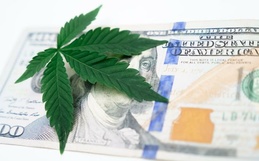
Lavender Fields Forever
Behind the blossoms at the Secret Garden at Brys Estate
By Brighid Driscoll | June 15, 2024
Though it’s called the Secret Garden, the secret’s been out for a while at Brys Estate on Old Mission Peninsula.
Walter and Eileen Brys own Brys Estate Vineyard and Winery and its not-so-secret sister property, the Secret Garden at Brys Estate. The garden is hidden by trees and sits lower on the property, and the pair would often come sit out at the site and enjoy its peaceful beauty.
“This was an area where we couldn’t grow grapes,” daughter and manager Katie Brys Elmasri says as she gestures to the garden’s nearly-blooming lavender fields. “The grapes sit up high, and the cold air settles down here.”
Northern Michigan is located on the 45th parallel, along with many other vineyards all over the world. On a trip to France, Elmasri’s mother was enchanted by the abundant lavender fields growing alongside vineyards. “And she thought that could work here.”
Everything’s Coming Up Lavender
In 2013, the first lavender row was planted to test whether it would take to the land. The plants grew large and lush, beginning what would grow into a 12-acre garden.
“For our purposes, because we distill essential oil, we harvest the plants for product. Lavender’s lifespan is around 10 to 15 years. But we don’t touch these ones because they’re so big and beautiful,” Elmasri says of those first plants.
There are 11 types of lavender grown at the garden, including varieties called Elizabeth and Violet Intrigue. English lavender (Lavandula angustifolia) is known for its sweet fragrance and is often used in culinary applications and essential oils, while French lavender (Lavandula dentata) has a more pungent aroma and serrated leaves, making it popular for ornamental purposes. Spike lavender (Lavandula latifolia) has a camphor-like scent, making it suitable for medicinal and cleaning products, and Lavandin (Lavandula x intermedia), a hybrid, combines qualities of both English and spike lavender.
“Coming out of winter, lavender looks really gray, and you might think, ‘Oh no, are my plants dead?’ But as spring rolls around they begin to green up again,” explains Elmasri. The lavender blooms in early July and engulfs the garden in purple.
In late July and early August, the harvesting begins. The process starts with picking the lavender when the flowers are in full bloom, ideally in the morning when the essential oil content is highest. Stems are cut close to the base and gathered into bundles.
Once harvested, the lavender bundles are taken to a distillery near the garden. Here, they’re placed in a copper still where steam is passed through the plant material. The steam helps release the essential oils from the flowers. This steam-oil mixture then travels through a cooling system, where it condenses back into liquid form. The liquid collected is a combination of water and essential oil. Since oil and water don’t mix, the essential oil floats on top and can be easily separated.
Purple Products
This beautiful, aromatic oil is then bottled and used in Brys products. The leftover lavender water, known as hydrosol, also has many uses, adding to the zero-waste charm of this process.
“We make a few simple things like hand soap, shower gel, bar soap, body lotion, and an eye mask made with cherry pits soaked in lavender oil,” Elmasri says. They also sell bundles of dried lavender, the aforementioned hydrosol, and of course, essential oil.
“People are sometimes surprised that the essential oil is expensive, but it takes around 52 bundles to make an ounce of oil,” Elmasri tells us.
Also for sale and worth experiencing is a collaborative ice cream with Moomers that is made with Brys lavender buds, lemon, and white chocolate chips.
Your Own Secret Garden
Wishing you had your own secret garden? Elmasri says that thanks to its beauty and many uses, lavender is a wonderful addition to your home. “Mosquitos don’t like lavender, neither do ticks or deer,” she says.
For best results, choose a sunny spot with well-draining soil, as lavender loves the sun and dislikes wet feet. Adding sand or gravel to your soil can improve drainage. Plant your lavender in the spring after the last frost, spacing plants about a foot apart to ensure good air circulation. Water them sparingly; lavender thrives in dry conditions. Mulching with small stones can help retain heat, and you should prune your plants in early spring to encourage bushy growth.
With a little care, you’ll enjoy beautiful, fragrant lavender all summer long. If you’d just like to experience the scents and colors, make a trip to the Secret Garden at Brys Estate at 3309 Blue Water Rd. in Traverse City. bryssecretgarden.com
The Benefits of Lavender
Humans have used lavender for centuries. The Egyptians used it in their elaborate mummification rituals, appreciating its preservative qualities and sweet aroma. Romans adored lavender for its versatility, using it to perfume bathwater, freshen the air, and flavor food. In medieval Europe, it was a staple in herb gardens, prized for its medicinal properties and believed to ward off evil. During the Renaissance, lavender gained popularity as a remedy for headaches and insect bites.
In the 20th century, lavender farming flourished, particularly in France, leading to its widespread use in essential oils and aromatherapy. Today, lavender continues to be celebrated for its calming fragrance and uses in wellness and beauty. Here are just a few ways to put that powerful purple plant to use:
Aromatherapy: Lavender essential oil is renowned for its calming and relaxing properties, helping to reduce stress and anxiety.
Sleep Aid: The soothing scent of lavender promotes restful sleep, making it a popular choice for pillows and diffusers in bedrooms.
Skin Care: Lavender oil has anti-inflammatory and antiseptic properties, which can help heal minor burns, insect bites, and acne.
Pain Relief: Massaging lavender oil into the skin can alleviate muscle soreness and joint pain.
Hair Care: Lavender oil is believed to improve scalp health and promote hair growth when used in hair treatments.
Natural Deodorant: Its pleasant scent and antimicrobial properties make lavender a natural choice for deodorants and fresheners.
Household Cleaner: Lavender’s antibacterial qualities make it an effective and fragrant ingredient in natural cleaning products.
Culinary Uses: Lavender adds a unique flavor to baked goods, teas, and savory dishes, enhancing culinary experiences.
Insect Repellent: The strong scent of lavender deters mosquitoes, moths, and other insects.
Trending

Michigan’s Marijuana Tax at Work
Cannabis has become a big business in northern Michigan, and local governments are putting tax dollars earned from dispensar… Read More >>
California Sober: Why People Are Switching from Alcohol to Weed
They call it “California sober.” Generally speaking, this term applies to folks who use marijuana but abstain f… Read More >>
The Legacy of Student Activism
“It’s a physical letter to your representative,” Alex Tank says when asked to define the word “prote… Read More >>


